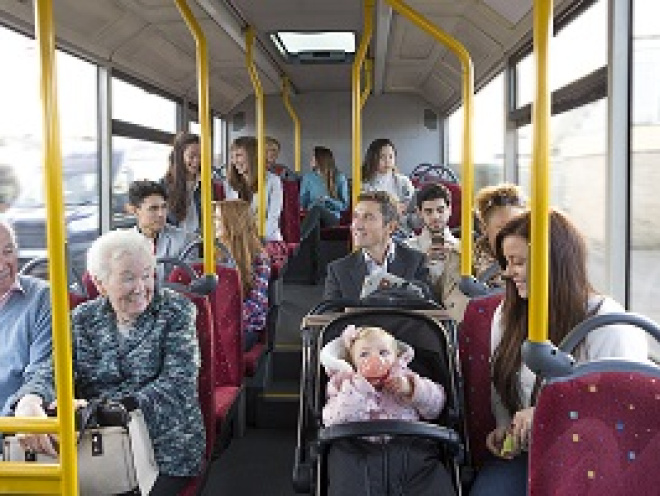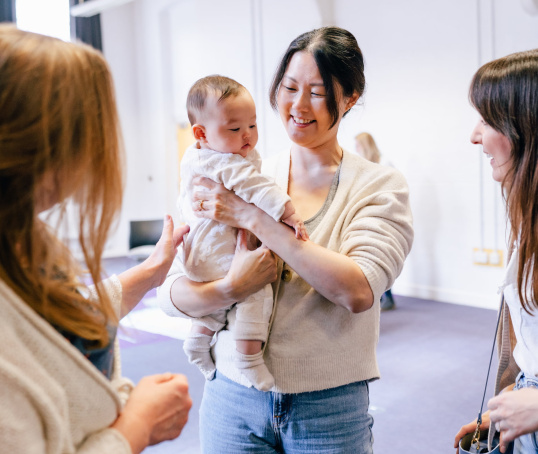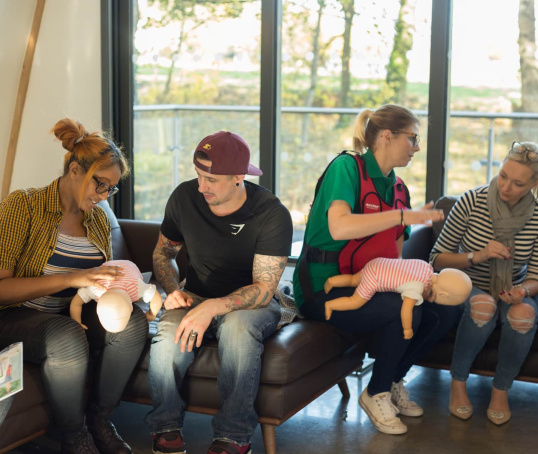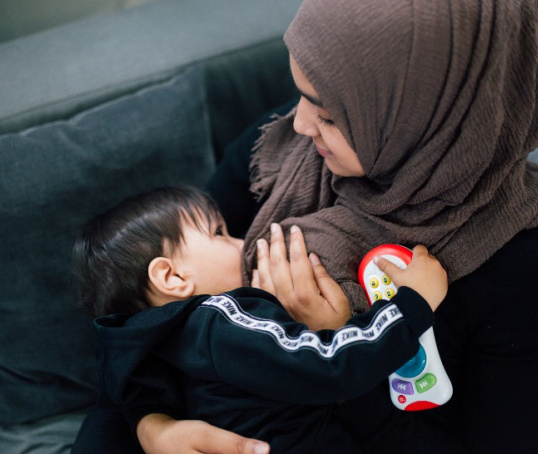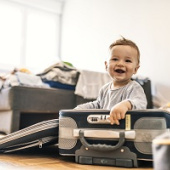Trains, tubes and buses can feel like an obstacle course when you have a baby. But don’t be intimidated – it’s all doable, with a few handy tips.
There are loads of reasons you might need to use public transport with your baby or toddler. Whether you’re visiting relatives, going on holiday or catching up with a friend over a coffee. And – let’s be honest – using public transport with a baby can feel a bit daunting. Especially the first few times.
Here are some ways to make it more comfortable (and less stressful).
1. Avoid rush hour whenever you can
Avoiding the chaos and busy commuters rushing alongside you and your child will make your journey less hectic (VisitBritain, 2017). This applies to mornings and evenings.
2. Time your journey around your child’s routine
If you have a younger baby, it can work well to travel during one of their naptimes. If you’re travelling by car, bear in mind that the advice for babies younger than four weeks is not to keep them in their car seat for longer than 30 minutes. And not more than two hours in one go for babies of all ages (The Lullaby Trust, 2016). Read more about this in our Driving with your baby article.
If your baby isn’t a good daytime napper or they’ve grown out of daytime naps, choose a time when they’re happiest. And no-one will know this better than you (Baby Can Travel, 2018).
3. Reserve a seat
If it’s a longer journey, it can be helpful to book tickets in advance. This way you can choose where to sit that works for you and your baby. Booking in advance will also save you money (My Train Ticket, 2013). You’ll need to check prices for children’s seats and at what age you have to pay for them with the train company you’re travelling with.
Window versus aisle seats is a personal preference. A window seat can be great for older babies or toddlers, as they can look at the sheep/cars/other trains going by. An aisle seat can be good if you need to get up and down a lot with an active toddler.
4. Pack carefully
Think about everything you might need in advance and pack accordingly. This might include nappies, wipes, snacks, more snacks, drinks, spare clothes, books and toys. A top tip from other parents is to put essentials in easy to reach places like your pockets or at the top of your bag. That way you’re not scrambling around when you need things (Baby Can Travel, 2018).
5. Leave giant prams at home
Try a small umbrella-fold type pram, or even better a baby carrier. Take a look at NCT Nearly New Sales to see if you can pick up a bargain (A Baby 0n Board, 2012).
Remember buses only have space for two pushchairs, and wheelchair users have priority by law. This means a driver might ask you to fold your pushchair before you get on. Or even not let you on if there are already two pushchairs onboard. This is when it pays to have a pushchair that you can fold down quickly and easily.
6. Buggy safety
It’s safest to get off buses or trains backwards, so you’re not tipping your baby or toddler forwards in their buggy. And always use your brake when waiting on station platforms or near the side of the road (A Baby on Board, 2012). Don’t forget to keep your baby or toddler safely strapped in as well.
7. Check out the stair situation in advance
Tube and train stations tend to have lots of steps. But you can check for step-free access before you travel to help plan your journey. Alternatively, ask someone to help you carry your buggy up or down stairs (TFL, 2018).
8. Where to sit…quiet, please
It might be best to avoid the quiet coach or zone on trains. Other passengers who have chosen to travel quietly might not be that welcoming if you bring a noisy baby or chatty toddler in… Many parents sit near the toilets where there’s often more space and flip-up seats to accommodate pushchairs (RailUK forums, 2015).
9. Plan ahead for changing and feeding
Some trains do have baby change facilities, though their cleanliness varies a lot.
If you’re planning to breastfeed, wear whatever feels comfortable for you to feed in. And don’t forget, it’s absolutely your right to breastfeed in public places including public transport, such as buses and trains (Maternity Action, 2018).
If you’re using formula milk, it might be a good idea to bring extra with you in case you get delayed or your train or the bus is cancelled. Some brands sell ready-made cartons that can be useful when you’re on the move (Baby Can Travel, 2018). Read more about preparing a formula feed safely.
10. Most importantly, enjoy it
Your toddler is likely to think a ride on a train is brilliant fun and your baby will get all kinds of stimulation from the passing scenery. And for you, it means that you’re hopefully en route to somewhere fun. So, enjoy – in fact embrace - the journey.
This page was last reviewed in June 2018.
Further information
Our support line offers practical and emotional support with feeding your baby and general enquiries for parents, members and volunteers: 0300 330 0700.
You might find attending one of our NCT New Baby courses helpful as they give you the opportunity to explore different approaches to important parenting issues with a qualified group leader and other new parents in your area.
Make friends with other parents-to-be and new parents in your local area for support and friendship by seeing what NCT activities are happening nearby.
A Baby on Board. (2012) How to travel by public transport in London, with a baby. Available at: https://www.ababyonboard.com/how-to-travel-by-public-transport-in-london-with-a-baby/ [Accessed 18th June 2018]
Baby Can Travel. (2018) Road trip with a baby: 7 essential tips. Available at:https://www.babycantravel.com/2015/09/14/road-trip-with-a-baby-7-essential-tips/ [Accessed 18th June 2018]
Maternity Action. (2018) Breastfeeding in public places. Available at https://maternityaction.org.uk/advice/breastfeeding-in-public-places/ [Accessed 18th June 2018]
My Train Tickets. (2013) Travelling by train with children. Available at:http://www.mytrainticket.co.uk/travelling-with-children [Accessed 18th June 2018]
RailUK Forums. (2015) Quiet coach etiquette. Available at:https://www.railforums.co.uk/threads/quiet-coach-etiquette.121945/ [Accessed 18th June 2018]
The Lullaby Trust. (2016) The Lullaby Trust's statement regarding new research on car seats. Available at: https://www.lullabytrust.org.uk/the-lullaby-trusts-statement-regarding-new-research-on-car-seats/ [Accessed 18th June 2018]
Transport for London. (2018) Planning a journey with your buggy. Available at:https://tfl.gov.uk/transport-accessibility/planning-a-journey-with-your-buggy [Accessed 18th June 2018]
VisitBritain. (2017) Family-friendly holiday guide. Available at:https://www.visitbritainshop.com/world/articles/family-travel-guide/ [Accessed 18th June 2018]
